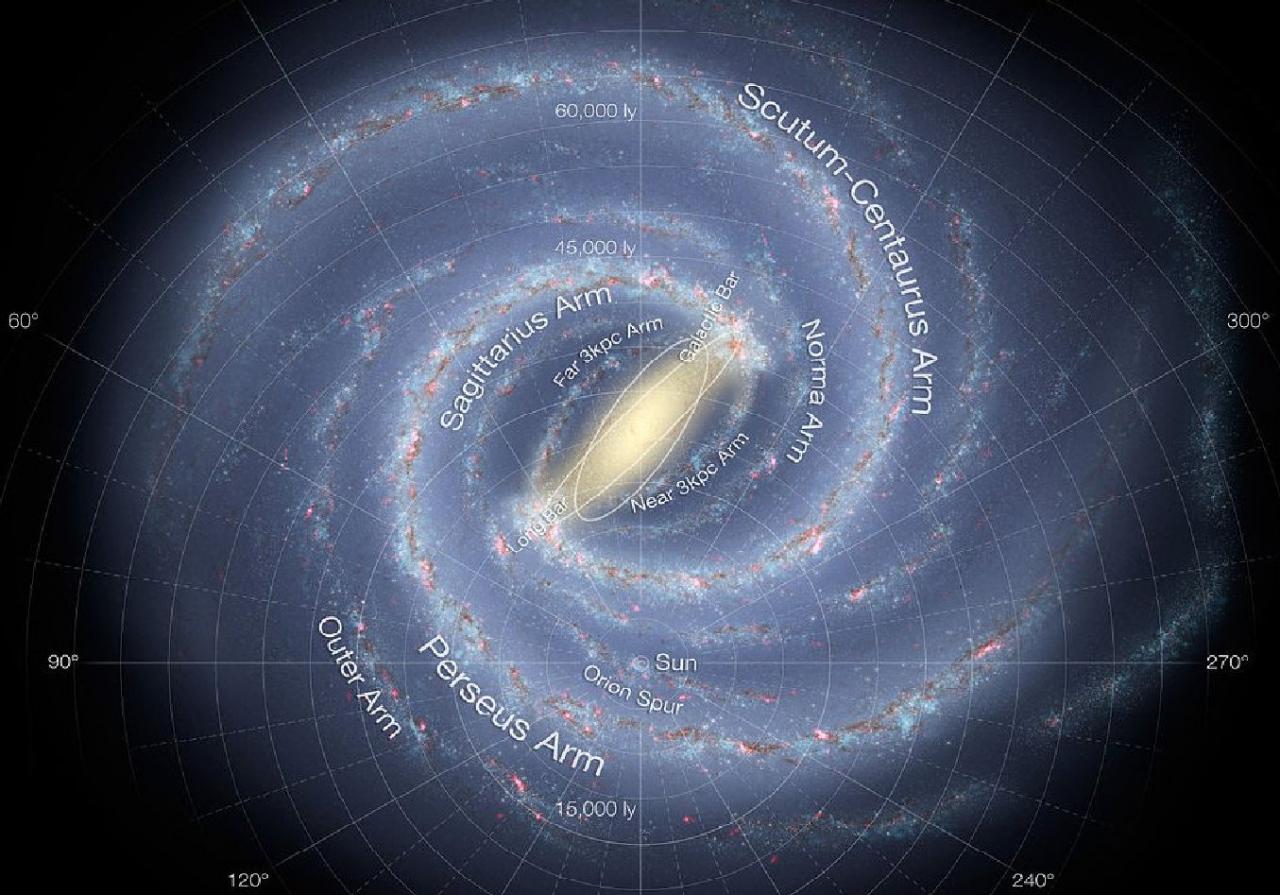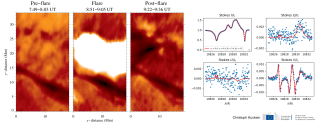Grants related:
General
This project consists of two parts, each differentiated but both complementary: morphology and dynamics. Detailed study of the morphology of the Milky Way pretends to provide a data base for the stellar distribution in the most remote and heavily obscured regions of our Galaxy, through the development of semiempirical models based on the information in these catalogues. Kinematic and dynamical analysis, on the other hand, aims to aid our understanding of the origin of these observed features.
Our group has used a combination of its own data (which will include in the future spectroscopical observations with GRANTECAN/EMIR) and public-domain catalogues either in photometry (DENIS, 2MASS, UKIDSS, VISTA, SDSS) or spectroscopy (SDSS-APOGEE in near infrared, LAMOST). We have gathered detailed information on the stellar distribution of the dominant populations over a wide area of sky containing different structural components: the triaxial bulge, the long bar, the disc, the spiral arms, etc. The components of gas and dust are also a matter of study in infrared, or in microwave (analyses of Galactic contamination over the cosmic microwave background radiation, for instance with WMAP or PLANCK). Our research team has also become part of the Spanish node of Gaia with the idea of orientating part of our work towards the scientific exploitation of this mission, particularly with regard to the identification and study of large scale stellar populations in the Galaxy.
Members
Results
- Milky Way's disk much larger than previously thought. See press release of IAC: http://www.iac.es/divulgacion.php?op1=16&id=1385&lang=en
Scientific activity
Related publications
-
Radial Velocities in the Outermost Disk toward the Anticenter
We measure the mean Galactocentric radial component of the velocity of stars (v R ) in the disk at 8 kpc < R < 28 kpc in the direction of the anticenter. For this, we use the Apache Point Galactic Evolution Experiment. Furthermore, we compare the result with H I maps along the same line of sight. We find an increase in positive (expansion) v R at R
López-Corredoira, M. et al.Advertised on:
12019 -
Roadmap search based motion planning for MIRADAS probe arms
MIRADAS is a near-infrared multiobject echelle spectrograph operating at spectral resolution R = 20,000 over the 1 to 2.5 μm bandpass for Gran Telescopio Canarias. It possesses a multiplexing system with 12 cryogenic robotic probe arms, each capable of independently selecting a user-defined target in the instrument field of view. The arms are
Sabater, J. et al.Advertised on:
72018 -
Characterization of a subsample of the Planck SZ source cluster catalogues using optical SDSS DR12 data
Aims: The Planck catalogues of Sunyaev -Zeldovich (SZ) sources, PSZ1 and PSZ2, are the largest catalogues of galaxy clusters selected through their SZ signature in the full sky. In 2013, we started a long-term observational programme at Canary Island observatories with the aim of validating ˜500 unconfirmed SZ sources. In this work we present
Streblyanska, A. et al.Advertised on:
92018 -
Optical identification of the binary companion to the millisecond PSR J2302+4442 with the Gran Telescopio Canarias
We report detection of the binary companion to the millisecond pulsar J2302+4442 based on the deep observations performed with the Gran Telescopio Canarias. The observations revealed an optical source with r' = 23.33 ± 0.02 and i' = 23.08 ± 0.02, whose position coincides with the pulsar radio position. By comparing the source colour and magnitudes
Kirichenko, A. Yu et al.Advertised on:
102018 -
Mapping the core of the Tarantula Nebula with VLT-MUSE. I. Spectral and nebular content around R136
We introduce VLT-MUSE observations of the central 2'× 2' (30 × 30 pc) of the Tarantula Nebula in the Large Magellanic Cloud. The observations provide an unprecedented spectroscopic census of the massive stars and ionised gas in the vicinity of R136, the young, dense star cluster located in NGC 2070, at the heart of the richest star-forming region
Castro, N. et al.Advertised on:
62018 -
The Sloan Digital Sky Survey Quasar Catalog: Fourteenth data release
We present the data release 14 Quasar catalog (DR14Q) from the extended Baryon Oscillation Spectroscopic Survey (eBOSS) of the Sloan Digital Sky Survey IV (SDSS-IV). This catalog includes all SDSS-IV/eBOSS objects that were spectroscopically targeted as quasar candidates and that are confirmed as quasars via a new automated procedure combined with
Pâris, I. et al.Advertised on:
52018 -
Disk stars in the Milky Way detected beyond 25 kpc from its center
Context. The maximum size of the Galactic stellar disk is not yet known. Some studies have suggested an abrupt drop-off of the stellar density of the disk at Galactocentric distances R ≳ 15 kpc, which means that in practice no disk stars or only very few of them should be found beyond this limit. However, stars in the Milky Way plane are detected
López-Corredoira, M. et al.Advertised on:
52018 -
3D Asymmetrical motions of the Galactic outer disc with LAMOST K giant stars
We present a three dimensional velocity analysis of Milky Way disc kinematics using LAMOST K giant stars and the GPS1 proper motion catalogue. We find that Galactic disc stars near the anticentre direction (in the range of Galactocentric distance between R = 8 and 13 kpc and vertical position between Z = -2 and 2 kpc) exhibit asymmetrical motions
Wang, H. et al.Advertised on:
72018 -
Chemical Abundances of Planetary Nebulae in the Substructures of M31. II. The Extended Sample and a Comparison Study with the Outer-disk Group
We report deep spectroscopy of 10 planetary nebulae (PNe) in the Andromeda Galaxy (M31) using the 10.4 m Gran Telescopio Canarias (GTC). Our targets reside in different regions of M31, including halo streams and the dwarf satellite M32, and kinematically deviate from the extended disk. The temperature-sensitive [O III] λ4363 line is observed in all
Fang, X. et al.Advertised on:
12018 -
Galaxy-wide radio-induced feedback in a radio-quiet quasar
We report the discovery of a radio-quiet type 2 quasar (SDSS J165315.06+234943.0 nicknamed the `Beetle' at z = 0.103) with unambiguous evidence for active galactic nucleus (AGN) radio-induced feedback acting across a total extension of ˜46 kpc and up to ˜26 kpc from the AGN. To the best of our knowledge, this is the first radio-quiet system where
Villar-Martín, M. et al.Advertised on:
122017 -
Stellar content of extremely red quiescent galaxies at z > 2 (Corrigendum)
Not Available
López-Corredoira, M. et al.Advertised on:
72017 -
Ultracool dwarf benchmarks with Gaia primaries
We explore the potential of Gaia for the field of benchmark ultracool/brown dwarf companions, and present the results of an initial search for metal-rich/metal-poor systems. A simulated population of resolved ultracool dwarf companions to Gaia primary stars is generated and assessed. Of the order of ˜24 000 companions should be identifiable outside
Marocco, F. et al.Advertised on:
102017 -
Stellar content of extremely red quiescent galaxies at z > 2
Context. A set of 20 extremely red galaxies at 2.5 ≤ zphot. ≤ 3.8 with photometric features of old passive-evolving galaxies without dust, with stellar masses of 1011M⊙, have colors that could be related to passive-evolving galaxies with mean ages larger than 1 Gyr. This suggests they have been formed, on average, when the Universe was very young (
López-Corredoira, M. et al.Advertised on:
42017 -
Absence of an X-shaped Structure in the Milky Way Bulge Using Mira Variable Stars
The stellar density distribution of the bulge is analyzed through one of its tracers. We use oxygen-rich Mira variables from the Catchpole et al. survey and OGLE-III survey as standard candles. The average age of these stars is around 9 Gyr. The population traced by Mira variables matches a boxy bulge prediction, not an X-shaped one, because only
López-Corredoira, M.Advertised on:
22017 -
The young open cluster NGC 7067 using Strömgren photometry
NGC 7067 is a young open cluster located in the direction between the first and the second Galactic quadrants and close to the Perseus spiral arm. This makes it useful for studies of the nature of the Milky Way spiral arms. Strömgren photometry taken with the Wide Field Camera at the Isaac Newton Telescope allowed us to compute individual physical
Monguió, M. et al.Advertised on:
42017 -
Dust in Clusters: Separating the Contribution of Galaxies and Intracluster Media
We have analyzed a sample of 327 clusters of galaxies, spanning the range of 0.06–0.70 in redshift. Strong constraints on their mean intracluster emission of dust have been obtained using maps and catalogs from the Herschel MerMES project; within a radius of 5 arcmin centered in each cluster, the 95% C.L. limits obtained are 86.6, 48.2, and 30.9
Gutiérrez, C. M. et al.Advertised on:
12017 -
Relativistic baryonic jets from an ultraluminous supersoft X-ray source
The formation of relativistic jets by an accreting compact object is one of the fundamental mysteries of astrophysics. Although the theory is poorly understood, observations of relativistic jets from systems known as microquasars (compact binary stars) have led to a well established phenomenology. Relativistic jets are not expected to be produced
Liu, Ji-Feng et al.Advertised on:
122015 -
Liverpool telescope 2: a new robotic facility for rapid transient follow-up
The Liverpool Telescope is one of the world's premier facilities for time domain astronomy. The time domain landscape is set to radically change in the coming decade, with synoptic all-sky surveys such as LSST providing huge numbers of transient detections on a nightly basis; transient detections across the electromagnetic spectrum from other major
Copperwheat, C. M. et al.Advertised on:
32015 -
Solar Space Density of the Red Clump Stars and the Scale-Length of the Thin Disc
We estimated the scale-length of the thin disc with the J and W1 magnitudes of the most probable red clump stars in the Galactic plane, - 0°.5 ⩽ b ⩽ +0°.5, in 19 equal sized fields with consecutive Galactic longitudes which cover the interval 90° ⩽ l ⩽ 270°. Our results are constrained with respect to the solar space density (D* = 5.95), which
Yaz Gökçe, E. et al.Advertised on:
42015 -
Optical Observations of Psr J2021+3651 in the Dragonfly Nebula With the GTC
PSR J2021+3651 is a 17 kyr old rotation powered pulsar detected in the radio, X-rays, and γ-rays. It powers a torus-like pulsar wind nebula with jets, dubbed the Dragonfly, which is very similar to that of the Vela pulsar. The Dragonfly is likely associated with the extended TeV source VER J2019+368 and extended radio emission. We conducted first
Kirichenko, A. et al.Advertised on:
32015



